Table of contents
- Test MV Agusta F4 MV Agusta F4
- MV Agusta F4 with lots of electronics on board
- This engine is an arsonist!
- 215 kilos willingly fall in an inclined position
- Technical specifications
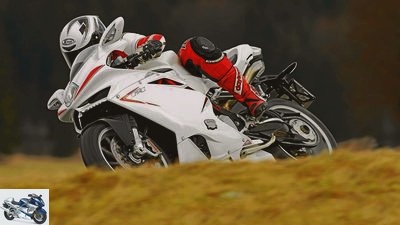
Bilski
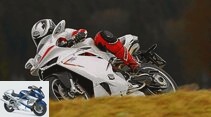
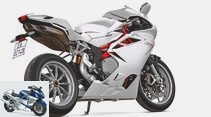
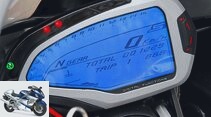
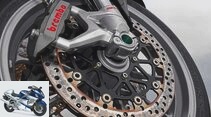
31 pictures
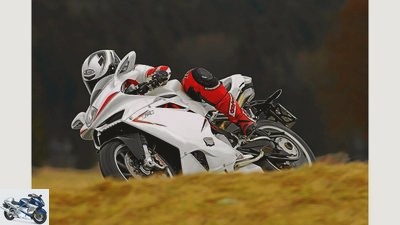
Bilski
1/31
The MV Agusta proves that even basic models can offer something tempting for connoisseurs.
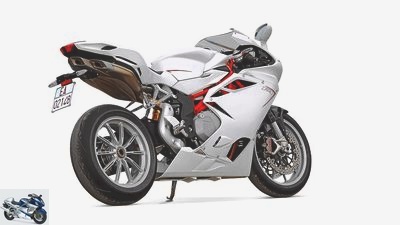
Bilski
2/31
Still of beguiling elegance. Not so nice that the swirling exhaust gives the backpack and clothes an unsightly scent after a few hours of driving.
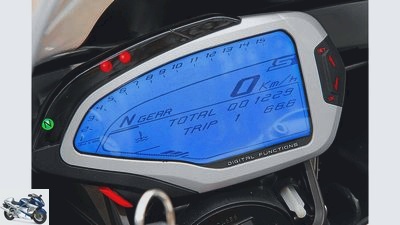
Bilski
3/31
The readability and wealth of information in the cockpit could be better.
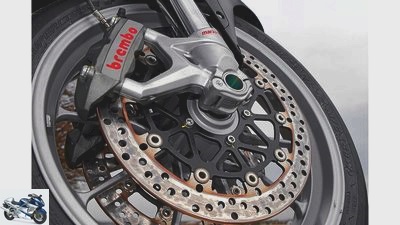
Bilski
4/31
High-speed and low-speed compression on the Sachs strut and thrust strut with height adjustment for the rear, no savings were made.
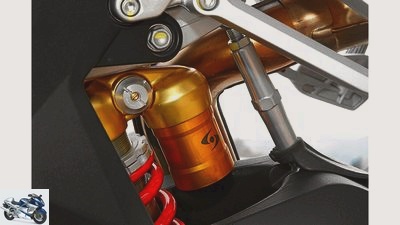
Bilski
5/31
The small piezo-electronic element on the gearshift lever provides the information for the ignition interruption depending on the speed, throttle valve position and gear, dimensions and performance are manageable.

Bilski
6/31
It’s nice that there is still something like this: quick release fastener for the front axle.

Bilski
7/31
Performance diagram of the MV Agusta F4.
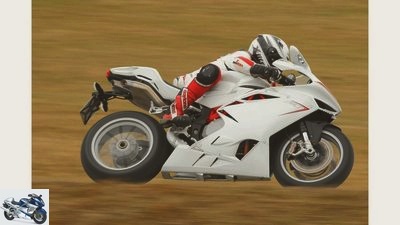
Bilski
8/31
MV Agusta F4 in the test.
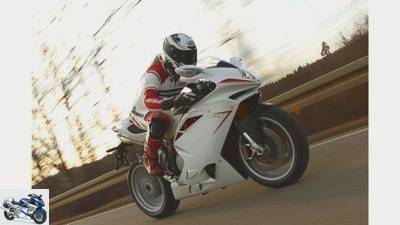
Bilski
9/31
MV Agusta F4 in the test.
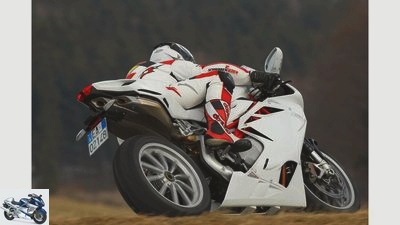
Bilski
10/31
MV Agusta F4 in the test.
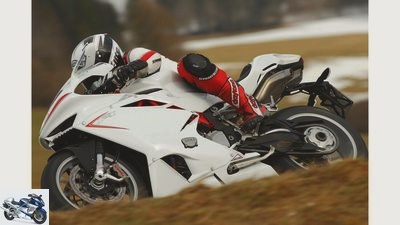
Bilski
11/31
MV Agusta F4 in the test.
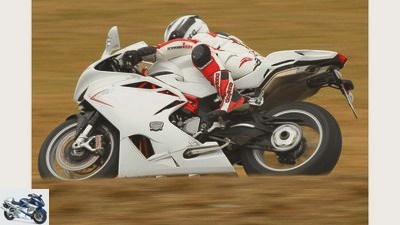
Bilski
12/31
MV Agusta F4 in the test.

Bilski
13/31
MV Agusta F4 in the test.
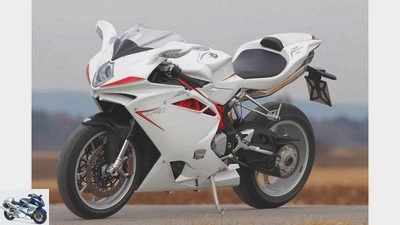
Bilski
14/31
MV Agusta F4 in the test.
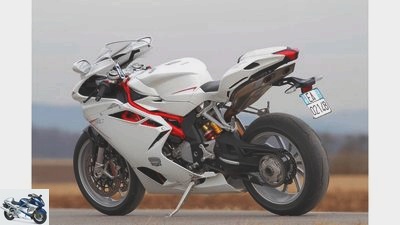
Bilski
15/31
MV Agusta F4 in the test.
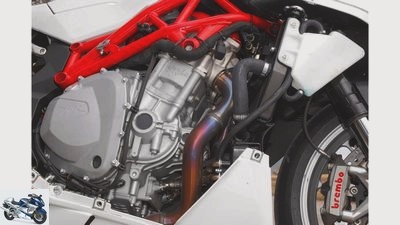
Bilski
16/31
MV Agusta F4 in the test.
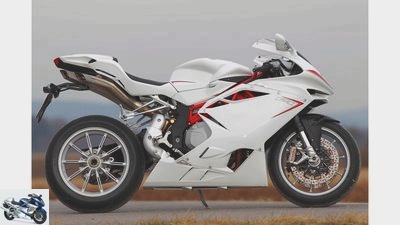
Bilski
17/31
MV Agusta F4 in the test.

Bilski
18/31
MV Agusta F4 in the test.
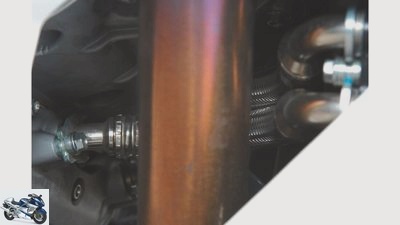
Bilski
19/31
MV Agusta F4 in the test.
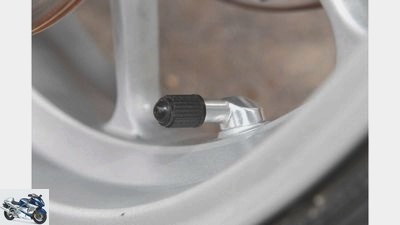
Bilski
20/31
MV Agusta F4 in the test.
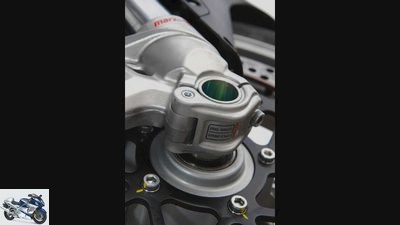
Bilski
21/31
MV Agusta F4 in the test.
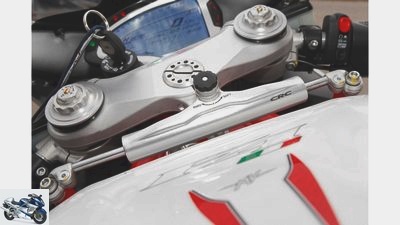
Bilski
22/31
MV Agusta F4 in the test.
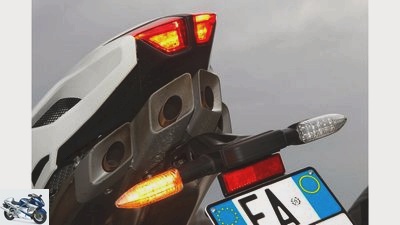
Bilski
23/31
MV Agusta F4 in the test.
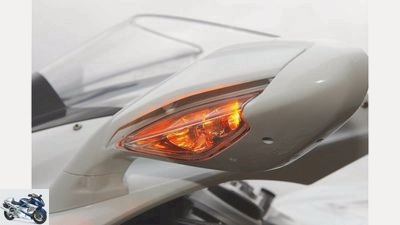
Bilski
24/31
MV Agusta F4 in the test.
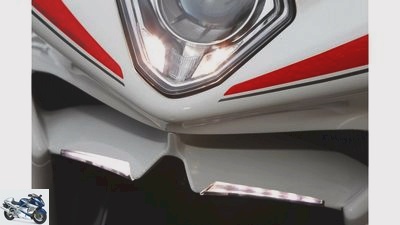
Bilski
25/31
MV Agusta F4 in the test.
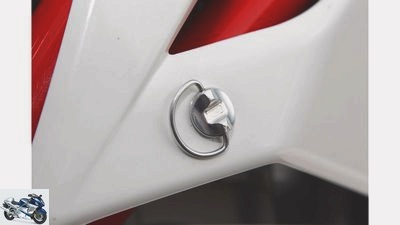
Bilski
26/31
MV Agusta F4 in the test.
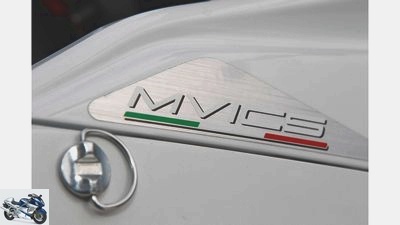
Bilski
27/31
MV Agusta F4 in the test.
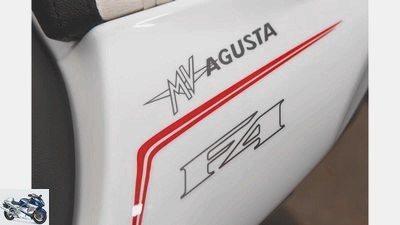
Bilski
28/31
MV Agusta F4 in the test.
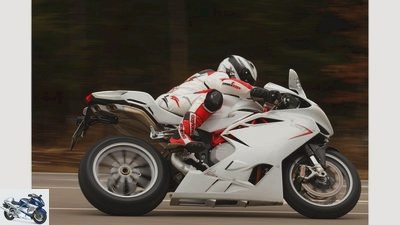
Bilski
29/31
MV Agusta F4 in the test.

Bilski
30/31
MV Agusta F4 in the test.
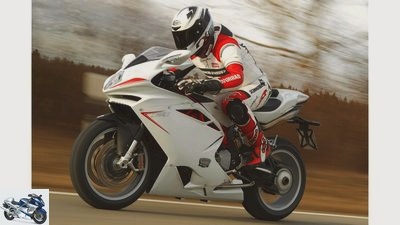
Bilski
31/31
MV Agusta F4 in the test.
counselor
technology & future
MV Agusta F4 in the test
Test MV Agusta F4
MV Agusta F4
Entry-level models are often savings options where Schmalhans is the master chef. The MV Agusta F4 proves that even a basic model can offer something tempting for connoisseurs.
Andreas Bildl
03/15/2013
Finally! The first rays of sun put an end to the dreary gray of what felt like an eternal winter and treat us to a few warm days. How fitting that the revised one right now MV Agusta F4 has found the way to us. Goodbye office, that has to be exploited. Combination on, gloves straightened and nothing like out of the Stuttgart valley basin.
The F4 is the basic model and entry-level model
into the F4 family, which also includes the more elegantly equipped F4 R and F4 RR. Lightweight forged wheels, electrically adjustable Ohlins suspension elements and 201 hp like that
The F4 does not offer the top model F4 RR. But now she also got the short-stroke Corsa-Corte engine with variable intake funnels and thus a power boost. 195 hp should be enough for the worst. There is also a lot of electronics on board: eight-stage traction control with lean angle sensor, automatic gearshift, various mappings (Sport, Normal, Rain with 150 hp) and of course the electronic throttle (ride-by-wire). For this purpose, the pilot can put together another mapping menu himself and specify the engine brake, engine response, sensitivity of the throttle grip and the rev limiter for each gear. Only one ABS is missing, but will follow later.
The way the March sun warms the air is great. The four-cylinder growls and cuts with devotion even at civil engine speeds, wonderfully and simply a pleasure. But the F4 has not only remained true to its sound when it comes to sound. The pegs up, the handlebars down, old-school ergonomics for athletes. Everything as far as before, including the unsuitable rearview mirror and the truck-like turning circle.
The little streets over the Swabian Alb are as if swept empty, just right for a cozy swing. One of the most important innovations remains discreetly in the background: the ride-by-wire. At low and medium speeds, it implements the gas commands unobtrusively.
Below 4000 rpm, the four-cylinder is still pretty cautious, but also gently on the gas, which makes itself Spitz-
let sweeping be mastered without any problems.
From 4000 rpm comes on for the first time
little life in the booth. But it gets really tingling when the bar on the badly readable rev counter passes the 8000 mark. Then he goes
Four cylinders off like a champagne cork. with
impressive roar and clear vibrations, he races up the speed ladder. At 10,000 rpm, when the funnels rise, the afterburner will ignite. In
the lower half of the speed is still good
the short stroke in the upper half to the animal, which with this performance characteristic is clearly conditioned for sport use.
Anyone who carelessly ignores the accelerator while accelerating in first gear should be prepared for the front wheel to be jerked towards the sky with vehemence.
This engine is an arsonist who wants to spin and power. However, at high speeds it clearly sets gas commands
tougher, reacts viciously to small gas commands, especially in sport mode.
Normal mapping is the better choice for country roads. Nevertheless: The ride-by-wire is much better coordinated than
with the three-cylinder from the same company.
At high speeds, the automatic gearshift lined up crisply gear after gear. Actually supposed to-
It also enabled downshifting without using the clutch, but this function has not yet been developed ready for series production and should be retrofitted later via software update free of charge. At medium speeds and with less load, however, gear changes are rather bony, so that out of consideration for the mechanics, you prefer to use the clutch.
On the other hand, the tried and tested monoblock calipers from Brembo do a full job when it comes to catching the F4 in time before a curve or an obstacle. Great to dose, not too toxic in the first grab. And the anti-hopping clutch holds during hard braking maneuvers, and still when measuring the acceleration
Noticeable unpleasantly with ugly plucking, the rear wheel safely under control.
The new, somewhat lighter ten-spoke cast wheels do not leave the F4
Hooks like a rabbit, but the MV, which weighs 215 kilos, willingly falls into an inclined position and confidently follows Lenk-
command. When tuning the spring elements, the mistake of overdoing it with the athletic rigidity was avoided. The Sachs shock absorber is tightly tuned, but still offers sufficient comfort. The Marzocchi fork is designed to be softer and more comfortable.
The walk to the gas pump reports gratifying progress. 5.9 liters of consumption are easily three quarters of a liter less than the predecessors swallowed. And that on top of that, at 16,990 euros, it lowers the hurdle for entry into the F4 family by around 1,500 euros, which makes the lovingly crafted beauty all the more appealing.
www.motorradonline.de/mvagusta
engine
Water-cooled four-cylinder four-stroke in-line engine, two overhead, chain-driven camshafts, four valves per cylinder, bucket tappets, wet sump lubrication, injection, Ø 50 mm, regulated catalytic converter, 350 W alternator, 12 V / 9 Ah battery, hydraulically operated multi-disc oil bath clutch (anti- Hopping), six-speed gearbox, O-ring chain, secondary ratio 41:15.
Bore x stroke 79.0 x 50.9 mm
Cubic capacity 998 cm³
Compression ratio 13.4: 1
Rated output 143.5 kW (195 PS)
at 13400 rpm
Max. Torque
111 Nm at 9600 rpm
landing gear
Steel tubular frame, load-bearing motor, upside-down fork, Ø 50 mm, adjustable spring base, rebound and compression damping, single-sided swing arm made of aluminum, central spring strut with lever system, adjustable spring base, rebound and compression damping, double disc brake at the front, Ø 320 mm, four-piston Fixed calipers, rear disc brake, Ø 210 mm, four-piston fixed caliper, traction control.
Cast aluminum wheels 3.50 x 17; 6.00 x 17
Tires 120/70 ZR 17; 200/55 ZR 17
Dimensions + weights
Wheelbase 1430 mm, steering head angle 66.0 degrees, caster 100 mm, spring travel f / h 120/120 mm, weight with a full tank of 215 kg, load 180 kg, tank capacity 17.0 liters. Warranty two yearsService intervals every 6000 kmColors white, red / silverPrice 16 990 euros ancillary costs 275 euros
Readings
Performance
Top speed * 295 km / h
acceleration
0-100 km / h 3.3 sec
0-140 km / h 4.8 sec
0-200 km / h 7.6 sec
Draft
60-100 km / h 4.8 sec
100-140 km / h 3.7 sec
140-180 km / h 4.0 sec
Speedometer deviation
effective (display 50/100)
47/95 km / h
consumption
Country road 5.9 l / 100 km
theoretical range 288 km
Fuel type super
Performance-
diagram
Buy complete article
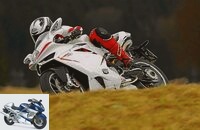
Test MV Agusta F4
MV Agusta F4
4 pages) as PDF
€ 2.00
Buy now
MV Agusta F4 with lots of electronics on board
The MV Agusta F4 is the basic model and entry into the F4 family, which also includes the more elegantly equipped F4 R and F4 RR. The F4 does not offer lightweight forged wheels, electrically adjustable Ohlins spring elements and 201 hp like the top model F4 RR. But now she also got the short-stroke Corsa-Corte engine with variable intake funnels and thus a power boost. 195 hp should be enough for the worst. There is also a lot of electronics on board: eight-stage traction control with lean angle sensor, automatic gearshift, various mappings (Sport, Normal, Rain with 150 hp) and of course the electronic throttle (ride-by-wire). For this purpose, the pilot can put together a further mapping menu himself and determine the engine brake, engine response, sensitivity of the throttle grip and the rev limiter for each gear. Only one ABS is missing, but will follow later.
The way the March sun warms the air is great. The four-cylinder growls and cuts with devotion even at civil engine speeds, wonderfully and simply a pleasure. But the MV Agusta F4 has not only remained true to its sound when it comes to sound. The pegs up, the handlebars down, old-school ergonomics for athletes. Everything as far as before, including the unsuitable rearview mirror and the truck-like turning circle. The little streets over the Swabian Alb are as if swept empty, just right for a cozy swing. One of the most important innovations remains discreetly in the background: the ride-by-wire. At low and medium speeds, it implements the gas commands unobtrusively.
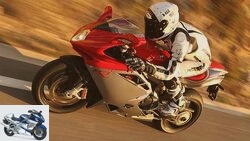
Super athlete
Driving report: MV Agusta F4 R
The super sports car from MV Agusta in the test
read more
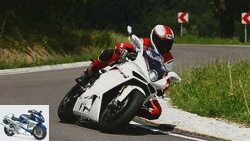
Super athlete
The new 200 hp super sports car from MV Agusta
Test: MV Agusta F4 RR
read more

Super athlete
Driving report: MV Agusta F3 675
Classy three-cylinder athlete from Italy
read more
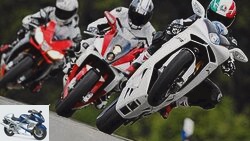
Super athlete
Comparison test: Italo super sports car 2011
MV Agusta F4 RR Corsacorte, Aprilia RSV4 Factory APRC, Bimota DB8 SP
read more
This engine is an arsonist!
Below 4000 rpm, the four-cylinder of the MV Agusta F4 is still pretty cautious, but also gently accelerates, which means that even hairpin bends can be mastered without any problems. A little life comes into the house for the first time from 4000 rpm. But it gets really tingling when the bar on the badly readable rev counter passes the 8000 mark. Then the four-cylinder goes off like a champagne cork. With an impressive roar and clear vibrations, it races up the speed ladder. At 10,000 rpm, when the funnels rise, the afterburner will ignite. Still good in the lower half of the speed, the short-stroke becomes an animal in the upper half, which with this performance characteristic is clearly conditioned for sport use.
Anyone who carelessly leaves the gas on while accelerating in first gear should be prepared for the front wheel to be jerked towards the sky with vehemence. This engine is an arsonist who wants to spin and power. However, it implements gas commands much harder at high speeds and reacts viciously to small gas commands, especially in sport mode. Normal mapping is the better choice for country roads. Nevertheless: The ride-by-wire is much better coordinated with the MV Agusta F4 than with the three-cylinder from the same company.
215 kilos willingly fall in an inclined position
At high speeds, the automatic gearshift lined up crisply gear after gear. Actually, the MV Agusta F4 should also enable downshifting without using the clutch, but this function has not yet been developed ready for series production and should later be retrofittable free of charge by means of a software update. At medium speeds and with less load, however, gear changes are rather bony, so that out of consideration for the mechanics, you prefer to use the clutch.
On the other hand, the tried and tested monoblock calipers from Brembo do a full job when it comes to catching the F4 in time before a curve or an obstacle. Great to dose, not too toxic in the first grab. And during hard braking maneuvers, the anti-hopping clutch, which was uncomfortably noticeable when measuring acceleration, keeps the rear wheel safely in check.
The new, somewhat lighter ten-spoke cast wheels do not let the MV Agusta F4 hit the hook like a rabbit, but the 215 kilo MV willingly falls into an inclined position and confidently follows the steering commands. When tuning the spring elements, the mistake of overdoing it with the athletic rigidity was avoided. The Sachs shock absorber is tightly tuned, but still offers sufficient comfort. The Marzocchi fork is designed to be softer and more comfortable.
The walk to the gas pump reports gratifying progress. 5.9 liters of consumption are easily three quarters of a liter less than the predecessors swallowed. And the fact that the new MV Agusta F4, at 16,990 euros, lowers the hurdle for entry into the F4 family by around 1,500 euros, makes the lovingly crafted beauty all the more appealing.
Technical specifications
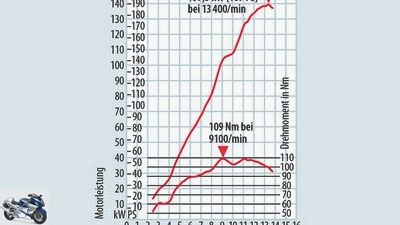
Bilski
Performance diagram of the MV Agusta F4.
engine
Water-cooled four-cylinder four-stroke in-line engine, two overhead, chain-driven camshafts, four valves per cylinder, bucket tappets, wet sump lubrication, injection, Ø 50 mm, regulated catalytic converter, 350 W alternator, 12 V / 9 Ah battery, hydraulically operated multi-disc oil bath clutch (anti- Hopping), six-speed gearbox, O-ring chain, secondary ratio 41:15.
Bore x stroke 79.0 x 50.9 mm
Cubic capacity 998 cm³
Compression ratio 13.4: 1
Rated output 143.5 kW (195 PS)
at 13400 rpm
Max. Torque
111 Nm at 9600 rpm
landing gear
Steel tubular frame, load-bearing motor, upside-down fork, Ø 50 mm, adjustable spring base, rebound and compression damping, single-sided swing arm made of aluminum, central spring strut with lever system, adjustable spring base, rebound and compression damping, double disc brake at the front, Ø 320 mm, four-piston Fixed calipers, rear disc brake, Ø 210 mm, four-piston fixed caliper, traction control.
Cast aluminum wheels 3.50 x 17; 6.00 x 17
Tires 120/70 ZR 17; 200/55 ZR 17
Dimensions + weights
Wheelbase 1430 mm, steering head angle 66.0 degrees, caster 100 mm, spring travel f / h 120/120 mm, weight with a full tank of 215 kg, load 180 kg, tank capacity 17.0 liters.
guarantee
two years
Service intervals
every 6000 km
Colors white, red / silver
Price 16,990 euros
Additional costs 275 euros
Readings
Performance
Top speed * 295 km / h
acceleration
0-100 km / h 3.3 sec
0-140 km / h 4.8 sec
0-200 km / h 7.6 sec
Draft
60-100 km / h 4.8 sec
100-140 km / h 3.7 sec
140-180 km / h 4.0 sec
Speedometer deviation
effective (display 50/100)
47/95 km / h
consumption
Country road 5.9 l / 100 km
theoretical range 288 km
Fuel type super
Related articles
-
fact motorcycles Top test Kawasaki Versys ABS Top test Kawasaki Versys ABS Quo Versys No tourer, no enduro, neither fun nor naked bike. Somehow the…
-
Gargolov motorcycles Comparison test: big bikes Comparison test: Big Bikes from Honda and Suzuki Test: Honda CBF 1000 F, CB 1300 S and Suzuki Bandit 1250…
-
Artist 48 pictures Artist 1/48 Four inexpensive motorcycles have appeared in the south of France … Artist 2/48 Artist 3/48 The winner of the 1000-point…
-
Comparative test of the mid-range all-rounder
fact 15th pictures 1/15 2/15 3/15 4/15 5/15 6/15 7/15 8/15 9/15 10/15 11/15 12/15 13/15 14/15 15/15 motorcycles Comparative test of the mid-range…
-
fact motorcycles Comparison test: Honda CBR 600 RR, Kawasaki ZX-6R, Suzuki GSX-R 600, Triumph Daytona 675, Yamaha YZF-R6 Comparison test: Honda CBR 600…
-
Aprilia NA 850 Mana and Honda NC 700 S DCT in the test
jkuenstle.de 12th pictures jkuenstle.de 1/12 Aprilia NA 850 Mana (variator) and Honda NC 700 S DCT (dual clutch transmission) – two automatic motorcycles…
-
Aprilia RSV4 R APRC ABS in the test
Gargolov 35 pictures Gargolov 1/35 The new Aprilia RSV4 R APRC ABS in the test. Gargolov 2/35 The new Aprilia RSV4 R APRC ABS in the test. Gargolov 3/35…
-
motorcycles Roll-out MV Agusta F4-750 Roll-out MV Agusta F4-750 Ago’s comeback Around a quarter of a century after his last World Championship title on…
-
archive 15th pictures Jahn, Suzuki 1/15 The world’s most powerful production motorcycle continues to brake without ABS. fact 2/15 Jahn, Suzuki 3/15 The…
-
A comparison of the super sports car MV Agusta F3 675 and Triumph Daytona 675
jkuenstle.de 11 pictures jkuenstle.de 1/11 The Triumph Daytona 675 (right) breaks all prejudices against 600s – at the same time, the elegant and handy…